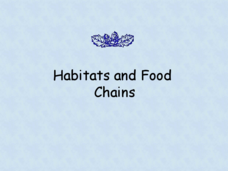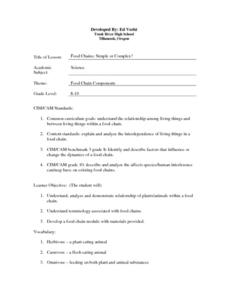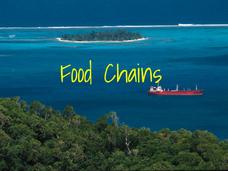National Park Service
Living & Non-Living Interactions
What better way to learn about ecosystems than by getting outside and observing them first hand? Accompanying a field trip to a local park or outdoor space, this series of collaborative activities engages children in learning about the...
World Wildlife Fund
Arctic Food Chain
Explore the food chains that support Arctic ecosystems. A class discussion on interdependence and the different roles plants and animals play in ecosystems provides students with the knowledge to complete a worksheet asking them to...
Curated OER
The Living Environment
In this living environment worksheet, students complete a crossword puzzle given 34 clues about the various species in the environment that produce, consume and decompose. Topics also include photosynthesis, respiration, glucose, organic...
Curated OER
Skulls Tell It All
Skulls tell it all, and with this lesson plan, you will tell it all to your class! Youngsters view animal skulls, analyzing the shape of teeth and the placement of the eye sockets. They associate these adaptations with the types of food...
Curated OER
Animal Skulls
Pictures of different animal skulls make this slide show fascinating. The intent is to display the differences in structure among herbivores, carnivores, and omnivores. If you do not have animal skull replicas, this presentation would be...
Curated OER
Habitats and Food Chains
Uncover the world of animal habitats, food chains, and the ecosystems with this well-put-together presentation. Each slide contains information and images that represent various aspects related to the ecosystem. Habitat, animal...
Curated OER
Food chains and webs
Here is an extremely simplistic look at food chains and webs. It depicts three different food chains, each containing a plant, plant eater, and meat-eater. Learners fill in the missing part of each chain by using the images provided at...
Curated OER
Sample Midyear Examination (Chemistry and Biology)
A 12-page midterm exam sample can be given to young scientists in preparation for an exam. This particular installment is geared toward a class that delves into both ecology and chemistry concepts. There is no way to separate the 50...
Curated OER
Nutritional Relationships Chart
Producers, Herbivores, Carnivores, Decomposers, oh my! Help organize the intricacies between these four types of eaters with this biology activity. Scientists display nutritional relationships in a graphic organizer. They place 15 terms...
Curated OER
Food Chains: Simple or Complex?
Students explore the relationships within the food chain between plants and animals. They construct modules of food chains, keeping them simple and not complex. They focus on what the animals eat and not on what eats it.
Curated OER
A Tooth for a Tooth
Learners classify mammals as carnivores or herbivores. They look at a set of pictures of animal skulls, observing the shape and size of the teeth, and identify herbivores and carnivores.
Curated OER
Food Chains
One of the topics elementary school kids love to study is the concept of a food chain. This presentation provides a basic overview of the food chain. It also has definitions for herbivore, carnivore, and omnivore. However, there is only...
Curated OER
Who Eats Who?
Students recognize that some animals eat plants, some eat meat and some both. For this who eats who lesson, students chart animals in a food chain. Students research information from reading articles. Students chart what animals eat...
Curated OER
The Dinosaur Diner
Students explore the food chain. In this dinoaur lesson, students identify charactersitics of an omnivore, carnivore, and herbivore. Students sort dinosaur picture/word cards into groups by their eating characteristics. Students also...
Curated OER
What Animals Need to Live
Fourth graders read "Habitat: What Animals Need to Live" then create a Venn diagram for herbivore, omnivore, and carnivore. For this animal survival lesson, 4th graders determine where different animals need to live depending on what...
Curated OER
GED Vocabulary: Life Science
In this life science GED learning exercise, students complete a crossword puzzle given 9 clues about structures of the nervous system, the circulatory system, evolution, the digestive system, molecules and fossils. Students are given a...
Curated OER
Striking a Balance
Students simulate animals in a food chain. In this food chain lesson plan, students are identified as grasshoppers, frogs or hawks. Popcorn is spread across a lawn and students are given baggies (stomachs) and colored sashes to identify...
Curated OER
Food Web
In this food web worksheet, students label the organisms shown as a producer or consumer and as a carnivore, herbivore or omnivore. Students create their own food web with a list of given animals.
Curated OER
The Food Chain
In this food chain worksheet, students draw a food chain plus describe and name an omnivore, herbivore, and carnivore. Students answer nine questions.
Curated OER
What Teeth Tell Us
Young scholars view pictures of a variety of animals. They examine the animals' teeth and discuss the differences in them. They experiment with staple removers (carnivore teeth) and two flat rocks (herbivore teeth) and determine which...
Curated OER
Habitats
Students complete food chains for organisms in three environments. They use copies of the Habitat worksheet. Students review the food chain terms with the teacher. They research related food chains, and interlink these to form a food...
Michigan Sea Grant
Food Chains and Webs
Starting with a simple food chain, young scientists interpret the difference and interrelatedness between herbivores, carnivores and producers. They answer questions related to cause and effect of food chain disruptions, including the...
Curated OER
Life And Death
Students participate in an interactive game to review how living things are classified.
Curated OER
Food Chains
Have your class discuss food chains using this presentation. This resource goes through a step by step exploration of plants and the food chain. It talks about the energy of the sun, producers and consumers, herbivores and carnivores,...

























